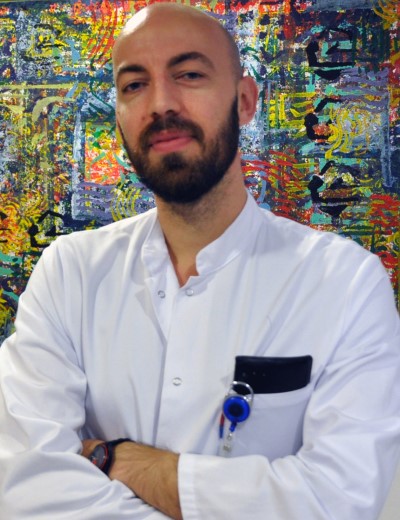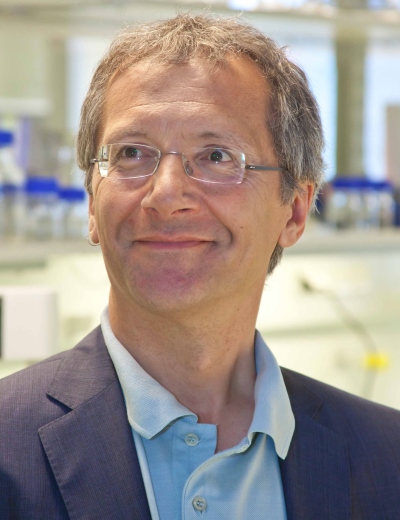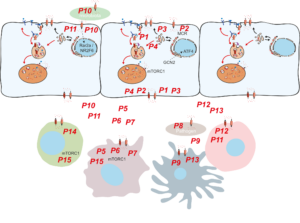15 fully funded PhD positions,
interconnected research projects (P1-P15)
and tandem supervision
It is our overall goal to provide control of metabolism and inflammation on the molecular, intra- and intercellular level in health and disease.
Short introduction of the individual PhD projects
The Question: How cells maintain membrane homeostasis and harmonize their lipid – and protein content is a major question in biology. We have recently shown that selective protein degradation pathways are essential to control lipid homeostasis and membrane integrity (Schmidt, O. et al. EMBO J. 2019, JBC 2020). The underlying molecular mechanism are only partially understood and it is unclear if defects in the processes can lead to metabolic diseases such as diabetes or fatty liver diseases.
The Goal is to characterize the molecular principles that coordinate lipid homeostasis with selective protein degradation pathways and to define if and how these processes contribute to the pathophysiology of metabolic diseases (e.g.: diabetes or non-alcoholic fatty liver disease).
Tandem Supervision Team

David Teis (Cell Biology)
basic researcher, Biocenter, Division of Cell Biology
Expertise: Membrane traffic, ubiquitin and signaling, mammalian and yeast genetics, membrane protein degradation, ESCRT machinery and reverse membrane budding, nutrient transporters
publications
personal website

Susanne Kaser (Internal Medicine)
physician scientist, Department of Internal Medicine
Expertise: Clinics and insulin resistance, obesity, type 2 diabetes, non-alcoholic fatty liver disease, fatty acid metabolism, growth hormone metabolism
publications
personal website
The Question: Dietary habits significantly contribute to the development of obesity, insulin resistance and non-alcoholic fatty liver disease and also determine the course of these diseases. Insulin together with several hormones affect hepatic lipid accumulation and inflammation in the liver by activating specific receptors in the liver. How nutrient uptake and hormones are linked in these diseases on the molecular and pathophysiological level is only partially understood.
The Goal is to characterize the role of specific hormones in the course of fatty liver disease and to investigate how nutrition modulates this disease on the molecular level.
Tandem Supervision Team

Susanne Kaser (Internal Medicine)
physician scientist, Department of Internal Medicine
Expertise: Clinics and insulin resistance, obesity, type 2 diabetes, non-alcoholic fatty liver disease, fatty acid metabolism, growth hormone metabolism
publications
personal website

David Teis (Cell Biology)
basic researcher, Biocenter, Division of Cell Biology
Expertise: Membrane traffic, ubiquitin and signaling, mammalian and yeast genetics, membrane protein degradation, ESCRT machinery and reverse membrane budding, nutrient transporters
publications
personal website
The Question: Research over the last two decades emphasized lysosome’s significance in coordinating cellular metabolism and changed the historic perception of lysosomes as organelles with solely a waste disposal function. Lysosomes house a sophisticated nutrient sensing machinery that integrates information about the cell’s energy levels, extra- and intracellular nutrient availability, stress factors and hormones. The LAMTOR-complex is an essential component of this machinery by recruiting and/or activating AMPK, MAPK and mTORC1 on the lysosomal surface. Signaling can be catabolic or anabolic, depending on which proteins LAMTOR interacts with. It remains unknown how the formation of these functionally distinct sub- complexes is regulated.
The Goal is to broaden our understanding of how lysosomal protein complexes orchestrate metabolic signaling on the molecular level. Special emphasis was put on phosphorylation as a regulatory mechanism in this context.
Tandem Supervision Team

Lukas A. Huber (Cell Biology)
basic researcher, Biocenter, Division of Cell Biology
Expertise: Cell biology of monogenetic diseases with a focus on lysosomes & LAMTOR, cell models, patient organoids and drug screening. CSO of the Austrian Drug Screening Institute (ADSI) & Center of Personalized Cancer Medicine- Oncotyrol
publications
personal website

Thomas Müller (Pediatrics)
physician scientist, Department of Pediatrics
Expertise: Clinics, genetics of congenital enteropathies and hereditary liver diseases
publications
personal website
The Question: Seizure threshold 2 (SZT2) is a very large and relatively unknown gene that is expressed mainly in the developing and mature brain. The SZT2 protein is 3375 amino acids long and is highly conserved among higher eukaryotes. SZT2 was shown to localize to lysosomes and associate with KPTN, ITFG2, C12orf66 in a quaternary complex called KICSTOR. This complex was shown to negatively regulate mTORC1 signaling in the absence of amino acids. SZT2 depletion prevents formation of the KICSTOR complex and triggers the constitutive localization of mTORC1 to the lysosomal membrane with persistent activation of the pathway, even under nutrient shortage. SZT2 was first identified in 2009 as a gene involved in epileptogenesis, conferring low seizure threshold to KO mice and with a putative role in resistance to oxidative stress. Since then, there have been several cases reporting that mutations in SZT2 are associated with Early infantile epileptic encephalopathy 18, a recessively inherited disease characterized by lack of psychomotoric development, dysmorphic facial features and early onset of refractory seizures. Nonetheless, the mechanism that links SZT2 to epilepsy remains unclear.
CRISPR/Cas9 edited knock out cell lines, patient material and cell lines harboring relevant patient mutations have been generated and are available to study the role of SZT2 and its interaction partners in physiological lysosomal signaling as well as in the context of diseases, such as Early infantile epileptic encephalopathy.
Tandem Supervision Team

Thomas Müller (Pediatrics)
physician scientist, Department of Pediatrics
Expertise: Clinics, genetics of congenital enteropathies and hereditary liver diseases
publications
personal website

Lukas A. Huber (Cell Biology)
basic researcher, Biocenter, Division of Cell Biology
Expertise: Cell biology of monogenetic diseases with a focus on lysosomes & LAMTOR, cell models, patient organoids and drug screening. CSO of the Austrian Drug Screening Institute (ADSI) & Center of Personalized Cancer Medicine- Oncotyrol
publications
personal website
The Question: The interaction of liver-resident macrophages (Kupffer cells) with hepatocytes is essential to maintain liver homeostasis. Our findings suggest a tight cholesterol-regulating cell-to-cell interaction between liver-resident Kupffer cells and hepatocytes (Demetz E et al., Eur Heart J. 2020). How this intercellular interaction regulates the quantity of circulating low-density lipoprotein cholesterol (LDL-C) during severe inflammation or upon depletion by Kupffer cell-directed chemotherapy is unclear.
The Goal is to gain molecular understanding on how Kupffer cells control LDL-C uptake in hyperlipidemia and atherosclerosis and to investigate if and how hepatic Kupffer cell numbers are regulated upon cholesterol accumulation.
Tandem Supervision Team

Ivan Tancevski (Internal Medicine-PS)
physician scientist, Department of Internal Medicine
Expertise: Clinics, atherosclerosis development, lipid metabolism, inflammation, hepatic and whole-body cholesterol metabolome.
publications
personal website

David Teis (Cell Biology)
basic researcher, Biocenter, Division of Cell Biology
Expertise: Membrane traffic, ubiquitin and signaling, mammalian and yeast genetics, membrane protein degradation, ESCRT machinery and reverse membrane budding, nutrient transporters
publications
personal website
The Question: Iron functions at the heart of cellular metabolism. A major route for iron uptake into cells requires clathrin-mediated endocytosis of the transferrin receptor (TfR). Defects in mTORC1 signaling impairs TfR mediated iron uptake and results in anemia development by mechanisms being still elusive.
The Goal: To determine how lysosomal mTORC1 signaling controls iron homeostasis in macrophages and how this regulates iron delivery to erythroid progenitor cells and thus hematopoiesis.
Tandem Supervision Team

Günter Weiss (Internal Medicine)
physician scientist, Department of Internal Medicine
Expertise: Clinics, immune-biology of infections with intracellular bacteria residing in the phago-lysosome of macrophages, immune-metabolism, cellular and systemic regulation of iron homeostasis
publications
personal website

Lukas A. Huber (Cell Biology)
basic researcher,Biocenter, Division of Cell Biology
Expertise: Cell biology of monogenetic diseases with a focus on lysosomes & LAMTOR, cell models, patient organoids and drug screening. CSO of the Austrian Drug Screening Institute (ADSI) & Center of Personalized Cancer Medicine-Oncotyrol
publications
personal website
The Question: Anemia of chronic disease (ACD) is a frequent entity occurring with immune activation (rheumatoid arthritis, infection and cancer). The underlying molecular and pathophysiological mechanism leading to ACD are incompletely understood.
The Goal is to understand how erythroid niche macrophages nurse and support the development of erythroid cells by supporting them with nutrients (e.g. iron) and growth factors in health and ACD.
Tandem Supervision Team

Igor Theurl (Internal Medicine)
physician scientist, Department of Internal Medicine
Expertise: Clinics, iron metabolism, hematopoiesis, innate immunity & infectious diseases, anemia of chronic disease
publications
personal website

Zlatko Trajanoski (Bioinformatics)
basic researcher, Biocenter, Division of Bioinformatics
Expertise: Bioinformatics and computational biology, metabolism, cancer immunology
publications
personal website
The Question: Aspergillus fumigatus is the most common human airborne fungal pathogen in Europe causing life-threatening systemic infection, termed aspergillosis, particularly in immunocompromised patients. This pathogen requires siderophore-mediated iron acquisition strategies for efficient infection.
The Goal is to understand how Aspergillus fumigatus uses transcriptional and metabolic reprogramming to adapt its iron uptake to host environments for efficient infection.
Tandem Supervision Team

Hubertus Haas (Molecular Biology)
basic researcher, Biocenter, Division of Molecular Biology
Expertise: Molecular biology, metabolism and physiology of infectious fungi. Focus on Aspergillus fumigatus and the role of siderophores & iron metabolism in secondary metabolism during infections
publications
personal website

Günter Weiss (Internal Medicine)
physician scientist, Department of Internal Medicine
Expertise: Clinics, immune-biology of infections with intracellular bacteria residing in the phago-lysosome of macrophages, immune-metabolism, cellular and systemic regulation of iron homeostasis
publications
personal website
The Question: The complement system is the major humoral arm of the innate immune system and studies in the last years revealed multiple novel actions of the complement system respecting immune regulation. Little is known how metabolic pathways fuel dendritic cell function upon complement receptor ligation and when DCs reside within different three-dimensional tissues.
The Goal is to characterize the role of the complement system in metabolic reprogramming of DCs for improved antigen processing and presentation during microbial infections at entry sites (intestinal mucosa, lung).
Tandem Supervision Team

Doris Wilflingseder (Hygiene and Medical Microbiology)
basic researcher, Division of Hygiene & Medical Microbiology
Expertise: Clinically relevant human infectious disease model, HIV-1, dendritic cell biology, T cell polarization, host-pathogen interactions, antigen processing and presentation
publications
personal website

Alexander Moschen (Internal Medicine)
physician scientist, Department of Internal Medicine
Expertise: Clinics, gastroenterology, clinically relevant models of intestinal inflammation and infection, metabolism and the microbiome, antimicrobial peptides
publications
personal website
The Question: Fatty liver disease is a spectrum disorder affecting up to 50% of the general population. Its manifestations range from asymptomatic non-progressive hepatic triglyceride accumulation to cirrhosis and hepatocellular carcinoma. Lipid droplet accumulation is the hallmark of fatty liver disease and is caused by a massive alteration of the lipid environment, cellular metabolism, and the molecular membrane architecture in all subcellular compartments. The underlying molecular changes of this dramatic morphologic change, the mediators of inflammation, fibrosis, and carcinogenesis are so far only superficially understood.
The Goal is to mechanistically link the changes in lipidome with the occurrence of known and novel genetic risk factors for f atty liver disease by combining tandem mass spectrometric lipidomics (REF) and patient centered and population genetics utilizing state-of-the-art bioinformatics approaches.
Tandem Supervision Team

Heinz Zoller (Internal Medicine)
physician scientist, Department of Internal Medicine
Expertise: Clinics, hepatocellular carcinoma, hepatology, fatty liver disease
publications
personal website

Markus Keller (Biochemical Genetics)
basic researcher, Institute of Humane Genetics
Expertise: inherited metabolic diseases, lipids, mass spectrometry, metabolomics/lipidomics, bioinformatics
publications
personal website
The Question: Gastrointestinal homeostasis is strongly dependent on nuclear receptor functions. They play a variety of roles ranging from nutrient uptake, sensing of microbial metabolites, regulation of intestinal epithelial cells function and barrier integrity to shaping of the intestinal immune cell repertoire.
The Goal is to understand how vitamin A regulates the functional interaction between the orphan nuclear receptor NR2F6 and RARa retinoic acid receptor (NR1B) in the healthy as well inflamed gastrointestinal tract.
Tandem Supervision Team

Natascha Kleiter (Translational Cell Genetics)
basic researcher, Division for Translational Cell Genetics
Expertise: Signal transduction in T lymphocytes, nuclear receptor function during immune tolerance and inflammation, mouse disease models of autoimmunity, colitis and cancer
publications
personal website

Alexander Moschen (Internal Medicine)
physician scientist, Department of Internal Medicine
Expertise: Clinics, gastroenterology,clinically relevant models of intestinal inflammation and infection, metabolism and the microbiome, antimicrobial peptides
publications
personal website
The Question: The majority of patients with colorectal cancer (CRC), a cancer for which tumor infiltrating lymphocytes represent a strong predictor of relapse and overall survival, does not benefit from the administration of a PD-1 targeting antibody – with the exception of patients with microsatellite instable genotypes. Our analysis suggests that the immunosuppressive environment in patients is mainly the result of infiltrating Foxp3-expressing regulatory T cells (Tregs) but the underlying molecular mechanisms are not clear.
The Goal is to dissect exact mechanisms by which Tregs migrate to and function within the hypoxic and nutrient competitive tumor microenvironment and to use this knowledge to modulate their function in CRC pharmacologically.
Tandem Supervision Team

Zlatko Trajanoski (Bioinformatics)
basic researcher, Biocenter, Division of Bioinformatics
Expertise: Bioinformatics and computational biology, metabolism, cancer immunology
publications
personal website

Igor Theurl (Internal Medicine)
physician scientist, Department of Internal Medicine
Expertise: Clinics, iron metabolism, hematopoiesis, innate immunity & infectious diseases, anemia of chronic disease
publications
personal website
The Question: Recent advances in the understanding of immune metabolism suggest that the metabolic space of the tumor microenvironment affects tumor immunity and dendritic cell function during melanoma development. Increasing levels of glutamate are detected during tumor progression, whereas inhibition of the glutamate pathway caused apoptosis in tumor cells.
The Goal is to investigate the metabolic changes in progressing melanomas and to dissect the functional consequences for tumor-infiltrating myeloid cells and subsequent T cell responses. This knowledge can be further exploited in the future to design novel therapeutic strategies for cancer patients.
Tandem Supervision Team

Patrizia Stoitzner (Dermatology)
basic researcher, Department Dermatology, Allergology, Venereology
Expertise: Dendritic cell biology and function, Langerhans and dermal dendritic cells, induction of T cell responses, dendritic cell-based immunotherapy, skin cancer models and tumor immunology
publications
personal website

Igor Theurl (Internal Medicine)
physician scientist, Department of Internal Medicine
Expertise: Clinics, iron metabolism, hematopoiesis, innate immunity & infectious diseases, anemia of chronic disease
publications
personal website
The Question: Upon antigenic challenge, lymphocytes boost their nutrient uptake and metabolic rate to afford growth and proliferation with cell cycle times below 10 hours. In consequence, lymphocytes can enter mitosis prematurely, which increases the risk of mis-segregating their chromosomes or even centrosomes. Extra centrosomes are frequently seen in human cancer and believed to suffice to drive malignant disease but the underlying molecular mechanisms are unclear.
The Goal is to understand how extra centrosomes contribute to the development of B cell malignancies or drive sterile inflammation.
Tandem Supervision Team

Andreas Villunger (Developmental Immunology)
basic researcher, Biocenter, Division of Developmental Immunology
Expertise: Apoptosis, autophagy, Bcl-2 family proteins, caspases, p53, mouse genetics, hematopoiesis, immunology
publications
personal website

Günter Weiss (Internal Medicine)
physician scientist, Department of Internal Medicine
Expertise: Clinics, immune-biology of infections with intracellular bacteria residing in the phago-lysosome of macrophages, immune-metabolism, cellular and systemic regulation of iron homeostasis
publications
personal website
The Question: mTOR signaling is crucial to control anabolic processes during the activation of T and B cells and to promote their proliferation. TORC1 inhibition by the immunosuppressive macrolide Rapamycin (Rapa, Sirolimus) causes an accumulation of the CDK inhibitor p27Kip, leading to cell cycle arrest in G1 phase, but the underlying mechanisms are not fully understood.
The Goal is to determine mechanistically how Rapamycin-dependent inhibition of mTORC1 signaling triggers p27 induction and cell cycle arrest in B cells and T cells.
Tandem Supervision Team

Ludger Hengst (Biochemistry)
basic researcher, Biocenter – Division of Biochemistry
Expertise: Restriction point control and cell cycle, CDK kinases and inhibitor proteins; ubiquitin ligases; signaling networks in mammalian cells and mouse models; translational control
publications
personal website

Ivan Tancevski (Internal Medicine-PS)
physician scientist, Department of Internal Medicine
Expertise: Clinics, atherosclerosis development, lipid metabolism, inflammation, hepatic and whole-body cholesterol metabolome
publications
personal website
Representatives
Sinead Iduna Schwabl MSc
Institut für Molekulare Biochemie
E-Mail: Sinead.Schwabl@i-med.ac.at
Isabel Singer M.Sc.
Institut für Zellbiologie
E-Mail: Isabel.Singer@i-med.ac.at

